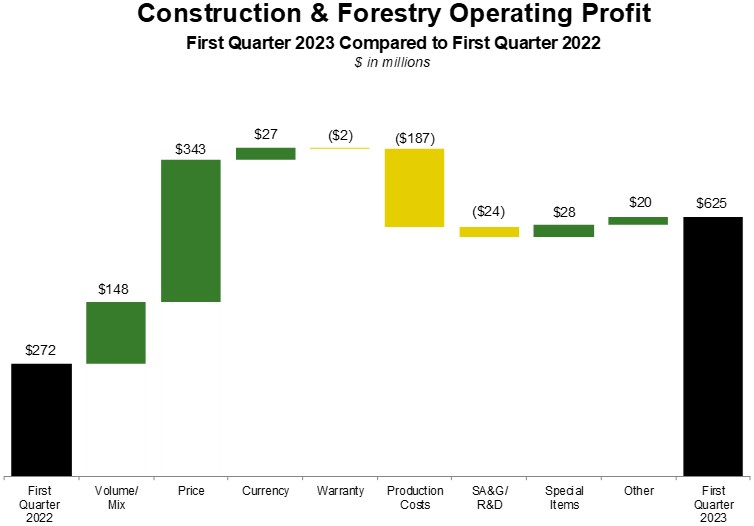percentage of total worldwide trade receivables outstanding for periods exceeding 12 months was 1 percent at each of January 29, 2023, October 30, 2022, and January 30, 2022.
Financing Receivables and Equipment on Operating Leases – Financing receivables and equipment on operating leases consist of retail notes originated in connection with financing of new and used equipment, operating leases, revolving charge accounts, sales-type and direct financing leases, and wholesale notes. Financing receivables and equipment on operating leases decreased by $720 million during the first quarter of 2023, primarily due to seasonal payments, and increased by $5,142 million in the past 12 months, due to strong retail sales. Total acquisition volumes of financing receivables and equipment on operating leases were 31 percent higher in the first three months of 2023, compared with the same period last year, as volumes of wholesale notes, operating leases, retail notes, and revolving charge accounts were higher, while finance leases were lower compared to January 30, 2022.
Inventories – Inventories increased by $1,561 million during the first three months, primarily due to a seasonal increase. Inventories increased $2,121 million, compared to a year ago, due to higher forecasted shipment volumes and supply chain disruptions, partially offset by the effect of foreign currency translation. A majority of these inventories are valued on the last-in, first-out (LIFO) method.
Property and Equipment – Property and equipment cash expenditures in the first three months of 2023 were $315 million, compared with $193 million in the same period last year. Capital expenditures in 2023 are estimated to be approximately $1,400 million.
Accounts Payable and Accrued Expenses – Decreased by $1,714 million in the first three months of 2023, primarily due to a decrease in accrued expenses associated with dealer sales discounts, employee benefits, and derivative liabilities. Accounts payable and accrued expenses increased $2,457 million compared to a year ago, due to an increase in accrued expenses associated with derivative liabilities, accrued taxes, and employee benefits, and an increase in accounts payable associated with trade payables.
Borrowings – Total external borrowings increased by $2,165 million in the first three months of 2023 and increased $6,754 million compared to a year ago, generally corresponding with the level of the receivable and the lease portfolio, as well as other working capital requirements.
John Deere Capital Corporation (Capital Corporation), a U.S. financial services subsidiary, has a revolving warehouse facility to utilize bank conduit facilities to securitize retail notes (see Note 9). The facility was renewed in November 2022 with an expiration in November 2023 and increased the total capacity or “financing limit” from $1,000 million to $1,500 million. At January 29, 2023, $786 million of securitization borrowings were outstanding under the facility. At the end of the contractual revolving period, unless the banks and Capital Corporation agree to renew, Capital Corporation would liquidate the secured borrowings over time as payments on the retail notes are collected.
In the first three months of 2023, the financial services operations retired $849 million of retail note securitization borrowings, which are presented in “Increase (decrease) in total short-term borrowings.”
Lines of Credit – The Company also has access to bank lines of credit with various banks throughout the world. Worldwide lines of credit totaled $8,327 million at January 29, 2023, $1,581 million of which were unused. For the purpose of computing unused credit lines, commercial paper and short-term bank borrowings, excluding secured borrowings and the current portion of long-term borrowings, were considered to constitute utilization. Included in the total credit lines at January 29, 2023 was a 364-day credit facility agreement of $3,000 million, expiring in the second quarter of 2023. In addition, total credit lines included long-term credit facility agreements of $2,500 million, expiring in the second quarter of 2026, and $2,500 million, expiring in the second quarter of 2027. These credit agreements require Capital Corporation and other parts of the Company to maintain certain performance metrics and liquidity targets. The Company expects to extend the terms of these credit facilities. All of these requirements of the credit agreements have been met during the periods included in the financial statements.
Debt Ratings – To access public debt capital markets, the Company relies on credit rating agencies to assign short-term and long-term credit ratings to the Company’s securities as an indicator of credit quality for fixed income investors. A security rating is not a recommendation by the rating agency to buy, sell, or hold Company securities. A credit rating agency may change or withdraw ratings based on its assessment of the Company’s current and future ability to meet interest and principal repayment obligations. Each agency’s rating should be evaluated independently of any other rating. Lower credit ratings generally result in higher borrowing costs, including costs of derivative transactions, and reduced access to debt capital markets. The senior long-term and short-term debt ratings and


